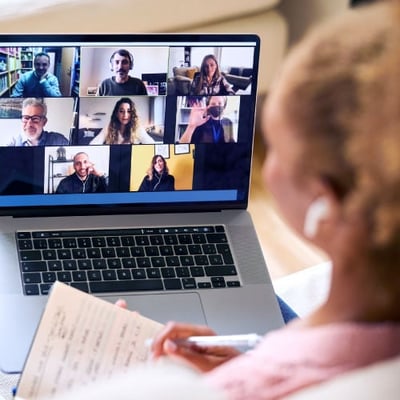Securing Video Conferencing: Ensure Privacy With User Verification
Video conferencing has come a long way since the sudden surge of the pandemic lockdowns. With this rise in usage, the technology became more robust, secure, and useful. Today’s video conferencing is more specialized and takes place in built-for-purpose applications, which brings vital utility to businesses and customers — like access to remote experts plus an array of virtual services across healthcare, finance, government, and other organizations. And all can now be augmented with virtual scribes, virtual backgrounds, virtual assistance, and more.
Identifying threats to video conferencing applications
Despite the benefits, video conferencing tools could open the door for online fraud and bad actors. According to the FBI’s Internet Crime Report for 2023, American consumers and business owners lost a record $12.5B last year to online scammers, marking a 22% spike in cybercrime over 2022. Similarly, Europol recently published a report on the types of fraud schemes, highlighting the increasingly sophisticated social engineering techniques employed by the criminals.
Just as video use has become the norm — so, too, is the fight to eliminate fraud using online video.
Securing the video streams
WebRTC-based video is already one of the most secure ways of transferring data online. Encryption and other security standards are mandated for all WebRTC sessions. Vonage Video API can be further customized to meet the highest security standards — including encrypted archiving, end-to-end media encryption, geofencing features used for compliance, and others.
As application developers continue to adapt, what other tools can they leverage to shield their users — and company’s reputation — from online fraud? Let’s find out.
Verifying video conferencing users
Two-factor authentication (2FA) is a popular and proven fraud prevention method for verifying a user's identity by requiring an additional layer of protection beyond just a username and password. Most forms of 2FA involve sending a one-time password (OTP) to a user’s device through SMS, WhatsApp, phone call, or email. 2FA is a powerful line of defense to protect both the business and user against fraud attacks. If hackers gain access to a user’s password, 2FA prevents them from logging into their account or joining a video conference.
With a programmable video API, you can “weave” video into your existing solution — or build entirely new services that tailor video to your exact needs, with prescribed mechanisms for access. 2FA is the icing on the security cake.
 Explore the infographic
Explore the infographic
Applications for two-factor authentication with video
Here are some use cases for companies implementing user verification to secure video:
Telemedicine
Remote patient consultations are a favorite for both patients and doctors because they are convenient and now ubiquitous. HIPAA-compliant video conferencing enables doctors to augment in-person care with remote consultations. Unfortunately, healthcare has been one of the hardest-hit industries for privacy and data breaches — as 88% of healthcare organizations have experienced a cyber attack.
By adding two-factor authentication, you gain an extra layer of security that prevents fraudulent transactions, account takeovers, and other vulnerabilities.
Remote work
Working from anywhere, video meetings, and video collaboration tools have become second nature for employees with “desk jobs.” While employees love the flexibility, companies everywhere are more susceptible to risk, especially if administrative controls and mandatory authentication are not implemented.
You can actively take steps to authenticate employees — even if they lose, damage, or upgrade their phone. Multiple device security enables the same 2FA accounts to sync across laptop, desktop, and mobile devices.
Government
As local and state governments seek to digitize and deliver their services more efficiently, video is viewed as a key enabler. Being able to deliver services remotely improves the constituent experience and service efficiency. This also allows employees to enjoy a hybrid work environment, which greatly improves morale and their experience.
However, governmental organizations naturally attract public scrutiny and draw attention through tax revenues and other financial input. It’s essential to integrate a 2FA workflow that complies with regulations to protect governmental networks and reduce vulnerabilities.
Finance
Digital banking, branch visits, and financial consultations have given way to video conferencing — so it’s critical to use 2FA to give customers peace of mind. One-time passwords (OTPs) sent by SMS are the most common way to drive verification. But an even more secure 2FA option, Silent Authentication, automatically verifies users through their mobile network without requiring them to input any passcodes. This improves both the user experience and removes the security risk of fraudsters trying to intercept OTPs.
A general best practice, which takes just a few lines of code, is to add a second factor to the verification process to ensure you are accepting logins from the right person.
Maintain the trust
Video is an everyday part of how we communicate and collaborate. That’s why it’s important to maintain trust between users and platforms, particularly when sensitive information may be shared. Adding another layer of authentication is an easy way to prevent fraudulent transactions, hacks, and malicious activity — and earn users trust.
Learn how Vonage Verify API and Vonage Video API can protect your video conversations.

